Wadi or Vadi are sun-dried lentil and spices dumplings. These are made with different kinds of lentils across Northern India. While in Rajasthan, there is the Mangodi which is made from moong lentils, the Punjabi variant is made with urad dal or moong dal and even fresh green chickpeas. These sun-dried lentils dumplings are further used to add to everyday vegetable curries or rice based dishes.
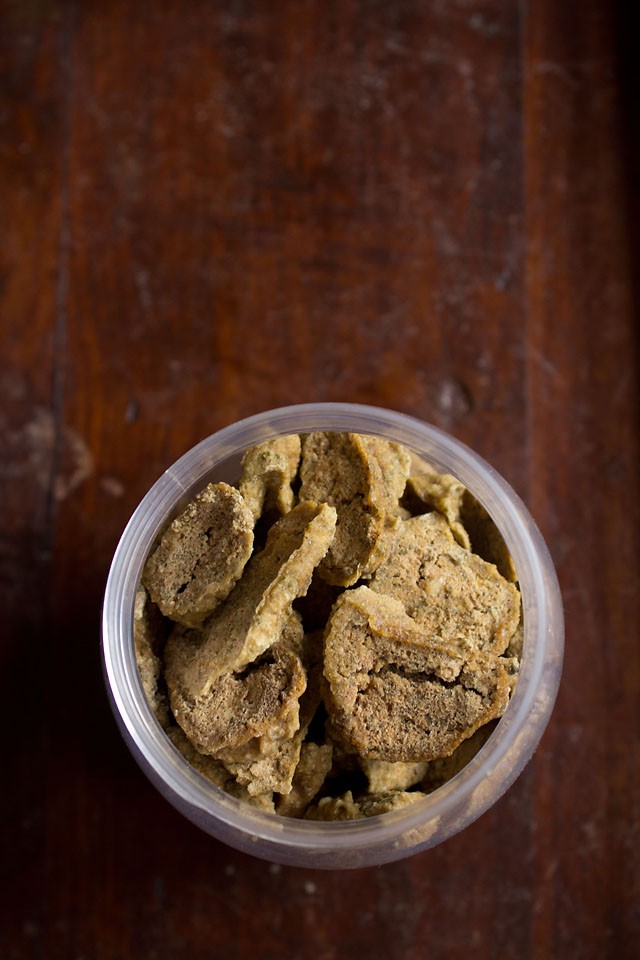
About Punjabi Wadi
As I have mentioned above, basically wadis are spiced dumplings made from a thick ground lentil and spices batter that are sun-dried.
The lentils are first soaked and then ground to a thick batter with spices and salt. Small portions of the batter is then sun dried.
After sun-drying, the wadi resembles small nuggets and look dry, thick and dense. They are meaty in texture as well as in taste.
Though not exactly tasting like meat, but a little close. These dumplings are also a great substitute for meat and the Soya Chunks (soya wadi) that we get in India.
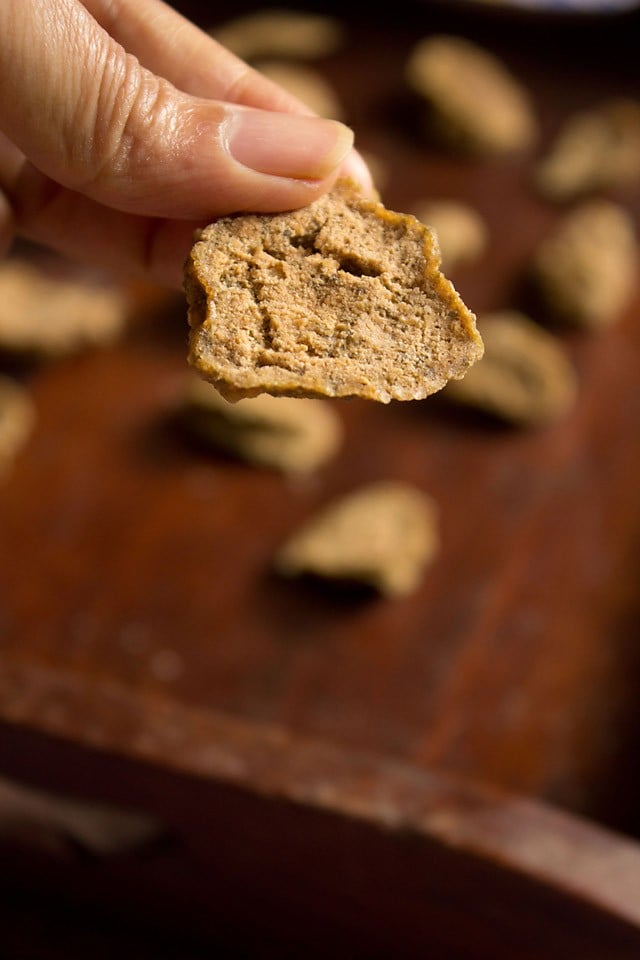
Plus they are vegan and can be made gluten-free if you do not add asafoetida (hing). You can add them to veggies and rice – even soups, pasta or noodles. They can also be fried and served as a side dish.
They soak up the sauce or gravy in which they are cooked and yet retain their texture, flavor and taste.
Generally these wadis are made in the winters when fresh green chickpeas also called as Cholia in Punjabi hits the market.
My mother-in-law makes Punjabi Wadi every year and here I share her recipe. It is really delicious and healthy.
We make the wadis with fresh green chickpeas/hara chana, moong dal or urad dal. Either use moong dal (hulled mung beans) or urad dal (hulled black gram) when making the wadis in combination with the fresh green chickpeas.
If you cannot get your hands on fresh green chickpeas, simply make these vadis with moong or urad dal.
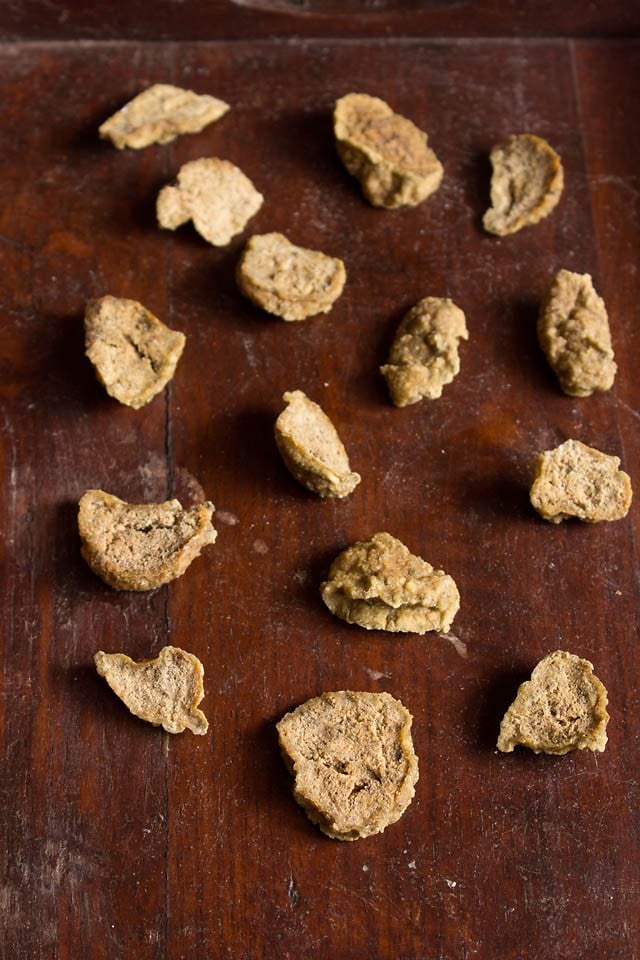
I have seen my mother-in-law would spending so much time peeling the green chickpea pods still attached to the fresh green bunch, and then making the wadis. In fact I used to help her in making the wadi mixture and then sun drying the vadis.
Oh yes and I do have memories of peeling the chickpea pods with my family back home. We would sit together and remove the chickpeas. Later mom would just boil the fresh chickpeas and have these sprinkled with some salt and chili powder. A warm and comforting snack in the Mumbai winters.
This Punjabi Vadi is spiced but not very heavily like like the spicy Amritsari vadi.

Once you have a whole jar of wadis, you can easily add them to your veggies or rice dishes.
We make the Punjabi wadi chawal or rice. The vadis are also added to potatoes to make the Aloo wadi sabji.
At home I generally add the wadis to Lauki (Bottle Gourd) Sabji and make. I also add them a sautéed dish made with white radish.
In the lauki wadi sabji, the spiced vadiyan balances the bland bottle gourd and it seems that this combo is made for each other. Below is the photo of this dish – a recipe which I have already posted.
Another point to make a note of: Since this is a homemade recipe, we adds whole cloves to the lentil mixture. So when you are eating the wadi and not careful, you will bite into the cloves and get a not so good strong astringent taste of the cloves in your mouth. So to avoid this, I suggest you to add clove powder to the lentil batter.
If you live in a place where you don’t get enough sun, then too you can make the wadis by oven drying them. Please check the notes section below on how to make oven dried Punjabi wadi.
More DIY Recipes
DIY & Collections
DIY & Collections
DIY & Collections
DIY & Collections
Please be sure to rate the recipe in the recipe card or leave a comment below if you have made it. For more vegetarian inspirations, Sign Up for my emails or follow me on Instagram, Youtube, Facebook, Pinterest or Twitter.
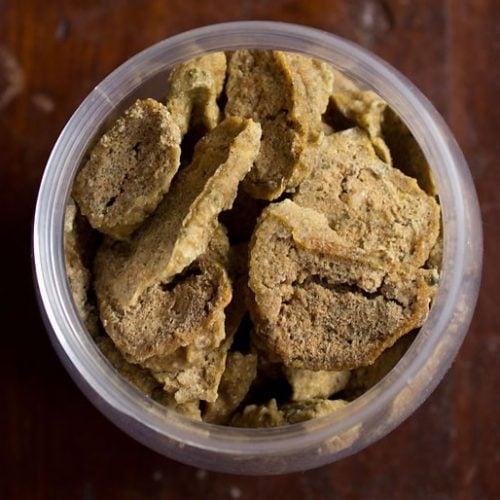
Punjabi Wadi | Vadi Recipe
Ingredients
- 1 cup fresh green chickpeas – in the absence of chickpeas, simply make the vadis with 2 cups of mung dal (hulled mung beans) or urad dal (hulled black gram) or ½ cup dried green chickpeas soaked overnight.
- 1 cup mung dal or urad dal
- 3 to 4 teaspoons cumin seeds
- ½ teaspoon asafoetida (hing) – the light variety
- 2 teaspoon cloves or ½ teaspoon clove powder
- 2 teaspoon black peppercorns or crushed black pepper
- salt as required
Instructions
Preparing the lentil batter
- Soak the fresh chickpeas in water for 2 to 3 hours.
- Also soak the mung dal or urad dal for 2 to 3 hours.
- Drain the chickpeas and grind it with very little water or no water to a fine, smooth and thick paste.
- Also grind the mung dal or urad dal with very little water or no water to a thick and fine, smooth paste.
- In a large bowl mix together both the chickpea paste and the mung dal or urad dal paste.
- Add all the spices and salt and mix well.
Sun-drying Vadi
- Take a large tray/plate or food safe plastic sheet.
- Keep the tray/plate on a mat in the sun.
- Drop spoonful of the the wadi mixture on the plate/tray or plastic sheet.
- You can shape them in small circles with the back of the spoon.
- Dry them in the sun for 2 to 3 days till they become hard.
- When one side is dried, then turn the wadis and dry the other side.
- You will have to turn these wadis a couple of times to ensure even drying.
- When done, store all the punjabi wadis in an air tight container.
Adding the vadis to any dish
- Rinse the vadis in water.
- Then add them to any veggie or rice based dish.
- Let them cook for 4 to 5 minutes.
- The vadis will become soft when cooked.
Notes
This Punjabi Vadi recipe post from the blog archives first published in July 2012 has been updated and republished on December 2022.
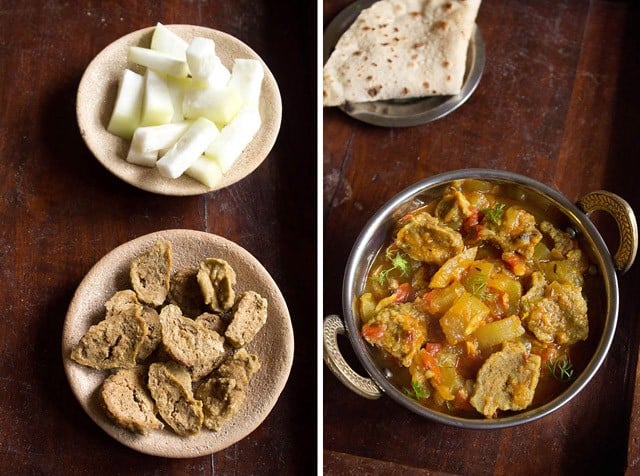
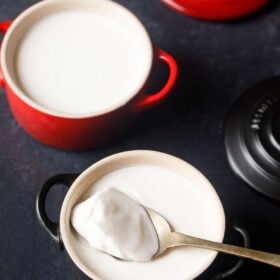
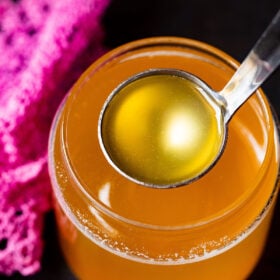
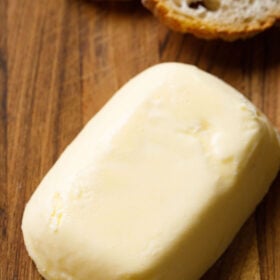
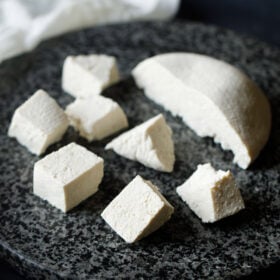
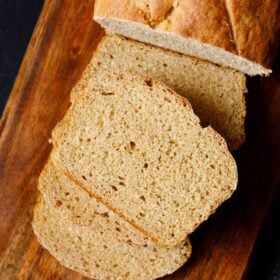
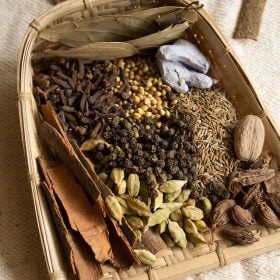
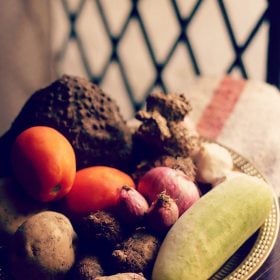








Wanted to know I just bought a bag of wadi from golden temple and was in plastic bag.
After I returned home wadi color has changed to dark brown is this still ok to eat.
It is difficult to tell as I have not seen the preparation of the wadi and also the current state of flavors, textures and color.
Wow great recipie…can u also send one to make amritsari wadi which has more spices
thanks preeti. will try to add the recipe.
I would like to know as we are using raw chickpeas and urad dal after soaking and grinding to dry up in sun, what is the shell life of these vadi. Can we cook them for a while on heat with little quantity of oil and then sun dry them.
I am a punjabi and have been eating these vadis which we usually bring from Amritsar and very ond of dishes made using these vadis. Will definetly try at home helping my mom and wife.
these vadis stay good for a year. usually we just grind the lentils and then sun dry. i have never made with cooking and then sun drying. so not sure what the final result will be. the amritsari vadis are more spicy than this one. you can add some crushed red chili paste to the ground lentils along with cumin, crushed black pepper and crushed cloves.
Is it ok if bake the wadi for 3-5 hours in oven?
yes. you can bake at a low temperature of about 60 to 80 degrees celsius for some hours or till the vadis have dried up.
One has to be very careful in making Waris in an oven. Even a slight higher temperature will make these so hard that they cannot be used or totally loose their taste.
thanks subhash for sharing this info. the wadis should always be baked at a very low temperature.
Hi
i want to purchase Amritsari vadi plz guide where can i get the same in mumbai.
chatter, i don’t know where it is available in mumbai.
we like punjabi wadis.
Hi, its really good to see recipe of wadiyan on your blog. I am looking for recipe of pumpkin wadiyan or pethe ki wadi. Do post it if you come across the recipe.Thanks!!
sure deepika
Wow! I just returned from a trip to the Golden Temple and got some amristari wadias back! Am now waiting for you to post the recipe for wadiya aloo/lauki wadiya. Hadn’t heard of the choliya variety until now but that sounds like a very healthy variation. Thx for the constant learnings from your posts:)
thats cool joyita. i will post both the lauki wadi and aloo wadi. lauki wadi is in drafts and i need to work on the post.
choliya variety is mil’s speciality. it is healthy indeed.
My dadi used to make these for the family & relatives etc during summers.I like the ones with moong dal & made a batch last year..still have it to last this year. I love the addition of fresh chickpeas here & the choice of spices.
I’ve never had punjabi wadi’s , might have had as kid but don’t really remeber the taste. But I have seen my neighbours drying them on the terrace during winters.
I agree this is so much more a helthier option than soy chunks.
My grand-ma used to make vadis at home.. and there are such sweet childhood memories associated with that. Our vadis are usually made of urad dal. I never liked eating them when I was a kid but love it now. I’ve been contemplating making vadis at home but the weather here is so unpredictable, very humid and it practically rains all year round.. not the right weather for making them.
dear vishakha, you can also make the wadis in the oven 🙂
wow..this is awesome blog!
thanks ashok.
These wadis look so interesting. I have seen the punjabi ones at the Indian Store but never bought them as I did not know what to expect. Now, I dont mind trying them out.
Missing wadiyan this year…did not visit mom..and am too lazy to do the whole process all by myself. May be your post will wake & shake me up a little to make my own wadiyan 🙂
drooooooooling dish of yours…sounds very interesting..
i think these can easily be used to replace the soy based meats in meaty curries! i should ask my mom why we never ate wadis growing up 🙂
yes richa, they can be easily used as substitute for mock meat as well as soy beased meats. they do have a meaty texture. i forgot to mention these points in the post. shall update the post. tell your mom to get some wadis for you when she visits you there.
Hey my Mil makes vadi’s with lauki in urad dal, it’s used regularly at my place in spicy yellow vadi chawal and many more recipes. But have never tasted vadi made from fresh choliya, need to give it a try too :). Even I use to help my mom during my childhood days in peeling the fresh chickpea pods, sweet memories revived :)…..
anamika, you must try the wadis made from choliya. they taste different than the mangodis – wadis made from moong dal or the urad dal wadis.
Madam,
Its raining in mumbai…..so can you pls repost this when its sunny….
can some artificial means of drying eg microwave be used? pls advice.
no red chillies?
Thanks for expanding the horizon of your readers…I am a north indian who is reading about wadis from you:)
i won’t be able to repost the recipe, but i can surely link it to my new posts.
i won’t suggest using the microwave for drying. it can really spoil the texture of these vadis. but still you can make them in the rains… in the oven 🙂
grease an over proof tray with oil or you can line the tray with butter paper. grease the butter paper with some oil. with the help of a spoon drop the wadi mixture in to the tray and shape them. keep some distance between the wadis. now bake the wadis at lower oven temperatures say between 50 to 100 degrees C for 3 to 5 hours till they get totally dried up and change their color. you will have to keep on checking in between. the time and temperature will vary from oven to oven.
do give this method of oven dried wadis a try. may be i will also post how to make the wadis in the oven. also thanks for your encouraging comments.
you can add red chili powder to make it spicy.
my husband love these wadis. Not my absolute fav but definitely like it once in a while 🙂
Looks yummy I am coming for dinner to your place.
anytime maria…
Looks delicious. I have never really tastes punjabi wadi. It sounds very tasty.